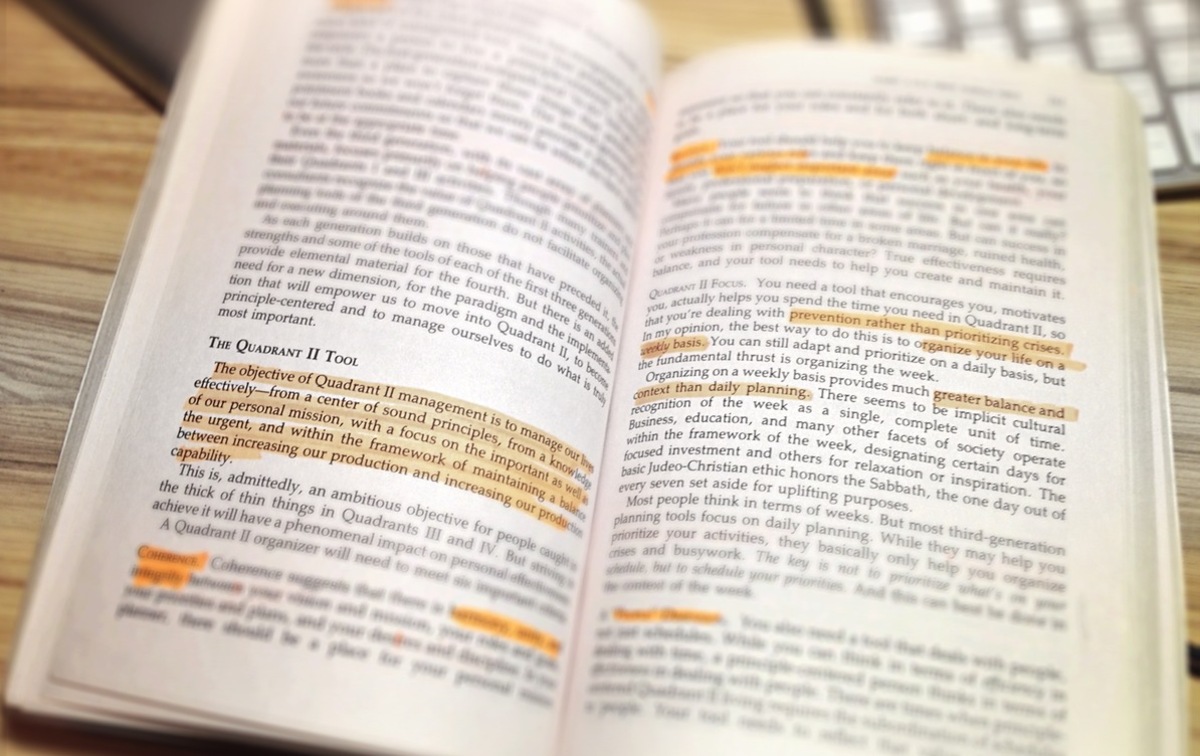Making Proper Marks in Books
My reading workflow consists of phases similar to the phases in GTD: collect, process, write. This post is about collecting.
To collect, it doesn’t help to paint your text in all colors of the rainbow. No matter how much you like to use highlighter pens: think about what you want to learn from the text first, and then decide whether marks are really the best tool for the job.
Marks aid understanding – but don’t overdo it

When you read a book, do you underline words or sentences or whole paragraphs? Do you use a colored text highlighter, a ballpoint pen or a pencil?
Manfred Kuehn thinks the way you treat a book is a sign of how civilized a reader you are. If you paint the pages you don’t know a lot about getting information and treating books. Also, underlining is utterly useless in most cases: you don’t magically remember the content better if you underline it word for word, sentence by sentence. Underlining won’t help you remember; marks are there to aid understanding in a later phase of reading.
Despite Kuehn’s point, you’re not supposed to consider yourself a caveman just because you use colored pens to put marks in texts: Umberto Eco states in How to Write a Thesis that you should use different colors for different questions, topics, points of view, and he says you should mark passages in color for revisiting the text.1 According to Eco, it’s useful to color-code your marks and reflect this code in your notes.
I agree that you should neither ruin other people’s property nor their reading experience of library books by painting the book’s pages, though. That’s just ruthless. But you’ll need to mark passages for further reference, else you’ll forget what you found important in the first place. So because you have to, use a pencil and erase your marks later if the book wasn’t yours. If you’re going to re-read the text and use it during future research, buy the book and use colored pencils if you like.
When I read, I collect everything that’s useful on paper. I practice ‘writing while reading’, if you like. Writing improves thinking, remember?
My collection phase consists of both putting marks in the margins and writing notes:
- I put pencil marks in both my own and library books. Nowadays, I simple put a dot • in the page margin to find the passage I want to pick up later. These little visual guides ease scanning the page.
- The text inspired a thought, and the inspiring part is already marked in the text. I only need to capture the thought during the collection phase. I used to write notes in the margins to remember what I had thought in re-reads of the book. Now, though, I write a summary or a unique thought on separate pieces of paper which I can physically pull out of the text.
Both the mark and the note will be useful when I process the text later. True understanding depends upon elaborate notes which I put into my Zettelkasten. I’ll expand the processing phase in another post.
Getting Fancy with Marks
For academic reading, I employ a tactic which is slightly more complex. My good friend Sascha suggested to divide text into its functionings:
- I circle terms which are being defined and write a
Dfor Definition in the margin. - When the author elaborates a model, I put an
Morμin the margin and maybe highlight key terms she uses. - If I spot an argument, I put an
Aorαin the margin and sometimes draw a vertical line in the margin to designate the passage. - Everytime I find a weakness in the argument or disagree due to a different starting point, I put a bolt glyph in the margin.
These glyphs I only use for texts in philosophy and sociology which tend to be more complex and need to be broken down into manageable parts. In nearly every other fiction and non-fiction book it’ll suffice to take note and aid the eye with unobstrusive marks.
Please tell me more about your own reading habits!
-
This is from on page 160 in the German translation of the book; I don’t know the page number of the newer English translation, though. If you find the place, please tell us about it! ↩